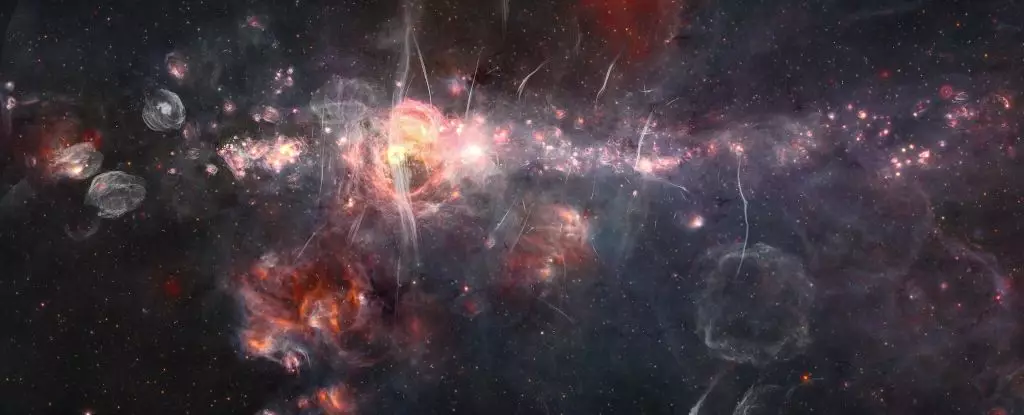The Milky Way is often portrayed as a serene spiral galaxy, yet its center presents a strikingly different picture. Home to a supermassive black hole, Sagittarius A*, this region is far from passive, brimming with dynamic events and magnetic phenomena. Among these chaotic activities is a newly identified source of high-energy gamma rays, dubbed HAWC J1746-2856. This discovery adds a layer of complexity to our understanding of cosmic ray acceleration within our galactic home. Utilizing data from the High-Altitude Water Cherenkov Observatory (HAWC) in Mexico, researchers have recorded gamma rays with astonishing energy outputs, challenging our existing notions about the dense environment surrounding the Galactic Center.
The HAWC observatory’s detection of 98 distinct gamma-ray events, all stemming from the same source near the galactic center, offers an unprecedented glimpse into extreme astrophysical processes. Each of these events showcases energies surpassing 100 teraelectronvolts, pushing the boundaries of what we thought was possible in our galaxy. Pat Harding from Los Alamos National Laboratory emphasizes the groundbreaking nature of these findings: they confirm the presence of a PeVatron—an extraordinary cosmic particle accelerator—situated in the Milky Way. PeVatrons are known to be instrumental in propelling cosmic rays to immense energies, and this specific instance reinforces the concept that our galaxy is a vibrant arena for high-energy physics.
What exactly constitutes a PeVatron? At its core, it’s a powerful natural accelerator that harnesses cosmic rays—primarily protons and atomic nuclei—forcing them to speeds approaching that of light. Such accelerators typically form in environments where gravitational forces, magnetic fields, and energetic explosions converge, such as supernova remnants, areas of star formation, or regions surrounding black holes. Yet, finding these accelerators in our galaxy has proven to be an arduous task. Harding elucidates that many processes thought to yield PeVatrons are both rare and often found in conditions that wouldn’t commonly occur within galactic confines.
When cosmic rays collide with denser materials, such as magnetic fields or interstellar dust clouds, they decelerate rapidly, giving rise to copious amounts of gamma radiation. However, the challenge lies in detecting these elusive particles. Exiting the galactic center, gamma rays struggle to penetrate the Earth’s atmosphere, which results in indirect observation methods. The HAWC facility is adept at detecting the secondary particles generated when gamma rays collide with atmospheric molecules, thus providing insights into their cosmic origins.
The significance of the HAWC J1746-2856 discovery cannot be overstated. The data collected over an extended observational period raises intriguing questions about the dynamics of cosmic rays within the Galactic Center. The detection of high cosmic ray densities exceeding galactic averages hints at a continuous influx of energetic protons in the region, potentially correlating with ongoing processes near the gravitational epicenter that is Sagittarius A*.
However, potential competing sources of gamma radiation, such as HESS J1746-285, remain a point of debate. The mystery surrounding HAWC J1746-2856’s identity may not yield immediate answers, necessitating advanced observational technologies to clarify the origin of these gamma rays. As researchers navigate this cosmic puzzle, the next generation of Cherenkov detectors promise to shed light on these enigmatic emissions, possibly revolutionizing our understanding of energy processes occurring in and around black holes.
The exploration of HAWC J1746-2856 serves as a reminder of the complexities and wonders of our universe. Despite significant advancements in cosmic ray physics, the identification and comprehension of PeVatrons in our galaxy remain an open field ripe for further investigation. The cooperative insights gained from HAWC’s data may very well enhance our knowledge of stellar processes, black hole physics, and the fundamental forces that govern the cosmos.
While it’s clear that the Milky Way’s core is anything but tranquil, ongoing studies like those surrounding HAWC J1746-2856 position us closer to unlocking the secrets of this chaotic cosmic expanse. As astrophysicists strive to piece together this intricate puzzle, the universe continues to reveal its formidable mechanisms, ultimately fueling our insatiable quest for understanding the extraordinary phenomena that lie beyond our planet.


Leave a Reply